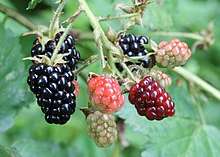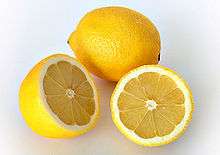Ripening



Ripening is a process in fruits that causes them to become more palatable. In general, fruit becomes sweeter, less green (typically "redder"), and softer as it ripens. Even though the acidity of fruit increases as it ripens, the higher acidity level does not make the fruit seem tarter. This is attributed to the Brix-Acid Ratio.[1]
Ripening agents
Ripening agents speed up the ripening process.
They allow many fruits to be picked prior to full ripening, which is useful, since ripened fruits do not ship well. For example, bananas are picked when green and artificially ripened after shipment by being gassed with ethylene.
Calcium carbide is also used in some countries for artificially ripening fruit. When calcium carbide comes in contact with moisture, it produces acetylene gas, which is quite similar in its effects to the natural ripening agent, ethylene. Acetylene acts like ethylene and accelerates the ripening process. Industrial-grade calcium carbide may also contain traces of arsenic and phosphorus which makes it a human health concern.[2] The use of this chemical for this purpose is illegal in most countries.[3][4]
Catalytic generators are used to produce ethylene gas simply and safely. Ethylene sensors can be used to precisely control the amount of gas.
Covered fruit ripening bowls are commercially available. The manufacturers claim the bowls increase the amount of ethylene and carbon dioxide gases around the fruit, which promotes ripening.
Climacteric fruits are able to continue ripening after being picked, a process accelerated by ethylene gas. Non-climacteric fruits can ripen only on the plant and thus have a short shelf life if harvested when they are ripe.
Some fruits can be ripened by placing them in a plastic bag with a ripe banana, as the banana will release ethylene.[5]
Ripening indicators
Iodine (I) can be used to determine whether fruit is ripening or rotting by showing whether the starch in the fruit has turned into sugar. For example, a drop of iodine on a slightly rotten part (not the skin) of an apple will stay yellow or orange, since starch is no longer present. If the iodine is applied and takes 2–3 seconds to turn dark blue or black, then the process of ripening has begun but is not yet complete. If the iodine becomes black immediately, then most of the starch is still present at high concentrations in the sample, and hence the fruit hasn't fully started to ripen.
Ripening stages
Climacteric fruits undergo a number of changes during fruit ripening. The major changes include fruit softening, sweetening, decreased bitterness, and colour change. Colour change is the result of pigments, which were always present in the fruit, becoming visible when chlorophyll is degraded.[6] However, additional pigments are also produced by the fruit as it ripens.[7]
In fruit, the cell walls are mainly composed of polysaccharides including pectin. During ripening, a lot of the pectin is converted from a water-insoluble form to a soluble one by certain degrading enzymes.[8] These enzymes include polygalacturonase.[6] This means that the fruit will become less firm as the structure of the fruit is degraded.
Enzymatic breakdown and hydrolysis of storage polysaccharides occurs during ripening.[6] The main storage polysaccharides include starch.[6] These are broken down into shorter, water-soluble molecules such as fructose, glucose and sucrose.[9] During fruit ripening, gluconeogenesis also increases.[6]
Acids are broken down in ripening fruits[9] and this contributes to the sweeter rather than sharp tastes associated with unripe fruits. In some fruits such as guava, there is a steady decrease in vitamin C as the fruit ripens.[10] This is mainly as a result of the general decrease in acid content that occurs when a fruit ripens.[6]
Different fruit have different ripening stages. In tomatoes the ripening stages are:
- Green: When the surface of the tomato is completely green
- Breaker: When less than 10% of the surface is red
- Turning: When less than 30% of the surface is red (but no less than 10%)
- Pink: When less than 60% of the surface is red (but no less than 30%)
- Light Red: When less than 90% of the surface is red (but no less than 60%)
- Red: When the surface is nearly completely red.[11]
List of ripening and non-ripening fruits
This is a list of fruits that are ripening and non-ripening after picking.
Ripening
Non-ripening
Ripening regulation
There are two patterns of fruit ripening: climacteric that is induced by ethylene and non-climacteric that occurs independently of ethylene.[12] This distinction can be useful in determining the ripening processes of various fruits, since climacteric fruits continue ripening after they are removed due to the presence of ethylene, while nonclimacteric fruits only ripen while still attached to the plant. In non-climacteric fruits, auxins act to inhibit ripening. They do this by repressing genes involved in cell modification and anthocyanin synthesis.[13] Ripening can be induced by abscisic acid, specifically the process of sucrose accumulation as well as color acquisition and firmness.[14] While ethylene plays a major role in the ripening of climacteric plants, it still has effects in non-climacteric species as well. In strawberries, it was shown to stimulate color and softening processes. Studies found that the addition of exogenous ethylene induces secondary ripening processes in strawberries, stimulating respiration.[15] They suggested that this process involves ethylene receptors that may vary between climacteric and non-climacteric fruits.
Methyl jasmonate
Jasmonate is involved in multiple aspects of the ripening process in non-climacteric fruits. This class of hormones includes jasmonic acid and methyl jasmonate. Studies showed that the expression of genes involved in various pathways in ripening was increased with the addition of methyl jasmonate.[12] This study found that methyl jasmonate led to an increase in red coloration and the accumulation of lignin and anthocyanins, which can be used as ripening indicators. The genes they analyzed include those involved in anthocyanin accumulation, cell wall modification, and ethylene synthesis; all of which promote fruit ripening.[12]
Abscisic acid
ABA also plays an important role in the ripening of non-climacteric plants. It has been shown to increase the rate of ethylene production and anthocyanin concentrations.[14] Ripening was enhanced, as seen with the accelerated fruit coloration and softening. This occurs because ABA acts as a regulator of ethylene production, increasing synthesis similarly to climacteric fruits.[14]
See also
- Bletting, a post-ripening reaction that some fruits undergo before they are edible
References
- ↑ Kimball, Dan (1991). "The Brix/Acid Ratio". Citrus Processing. Springer Netherlands: 55–65. doi:10.1007/978-94-011-3700-3_4.
- ↑ Per, Hüseyin; Kurtoğlu, Selim; Yağmur, Fatih; Gümüş, Hakan; Kumandaş, Sefer; Poyrazoğlu, M. Hakan (2007). "Calcium carbide poisoning via food in childhood". The Journal of Emergency Medicine. 32 (2): 179–80. doi:10.1016/j.jemermed.2006.05.049. PMID 17307629.
- ↑ "Bet on it. Your mango is ripened using carbide". dnaindia.com. May 18, 2013. Retrieved 18 May 2013.
- ↑ "The toxic truth about ripe mangoes". Indian Express. 18 May 2013. Retrieved 18 May 2013.
- ↑ "How to Ripen Fruit Faster".
- 1 2 3 4 5 6 Prasanna, V.; Prabha, T.N.; Tharanathan, R.N. (2007). "Fruit ripening phenomena-an overview". Critical Reviews in Food Science and Nutrition. 47 (1): 1–19. doi:10.1080/10408390600976841. PMID 17364693.
- ↑ Atwell, Brian J.; Kriedemann, Paul E.; Turnbull, Colin G.N., eds. (1999). "11.5.5 Colour and flavour". Plants in Action: Adaptation in Nature, Performance in Cultivation. Macmillan Education Australia. ISBN 0732944392.
- ↑ Xuewu Duana; Guiping Chenga; En Yanga; Chun Yia; Neungnapa Ruenroengklina; Wangjin Lub; Yunbo Luoc; Yueming Jiang (November 2008). "Modification of pectin polysaccharides during ripening of postharvest banana fruit". Food Chemistry. 111 (1): 144–9. doi:10.1016/j.foodchem.2008.03.049.
- 1 2 Medlicott, A.P.; Thompson, A.K. (1985). "Analysis of sugars and organic acids in ripening mango fruits (Mangifera indica L. var Keitt) by high performance liquid chromatography". J. Sci. Food Agric. 36 (7): 561–6. doi:10.1002/jsfa.2740360707.
- ↑ Bashir, H.A.; Abu-Goukh, A.A. (2003). "Compositional changes during guava fruit ripening". Food Chemistry. 80 (4): 557–563. doi:10.1016/j.foodchem.2008.03.049.
- ↑ "Guide to ripening stages" (PDF). Lagorio family companies.
- 1 2 3 "Methyl jasmonate treatment induces changes in fruit ripening by modifying the expression of several ripening genes in Fragaria chiloensis fruit". Plant Physiology and Biochemistry. 70: 433–444. 2013-09-01. doi:10.1016/j.plaphy.2013.06.008. ISSN 0981-9428.
- ↑ Aharoni, Asaph; Keizer, Leopold C. P.; Broeck, Hetty C. Van Den; Blanco-Portales, Rosario; Muñoz-Blanco, Juan; Bois, Gregory; Smit, Patrick; Vos, Ric C. H. De; O'Connell, Ann P. (2002-07-01). "Novel Insight into Vascular, Stress, and Auxin-Dependent and -Independent Gene Expression Programs in Strawberry, a Non-Climacteric Fruit". Plant Physiology. 129 (3): 1019–1031. doi:10.1104/pp.003558. ISSN 0032-0889. PMC 166497. PMID 12114557.
- 1 2 3 Jiang, Yueming; Joyce, Daryl C. (2003-02-01). "ABA effects on ethylene production, PAL activity, anthocyanin and phenolic contents of strawberry fruit". Plant Growth Regulation. 39 (2): 171–174. doi:10.1023/A:1022539901044. ISSN 0167-6903.
- ↑ Tian, M. S.; Prakash, S.; Elgar, H. J.; Young, H.; Burmeister, D. M.; Ross, G. S. (2000-09-01). "Responses of strawberry fruit to 1-Methylcyclopropene (1-MCP) and ethylene". Plant Growth Regulation. 32 (1): 83–90. doi:10.1023/A:1006409719333. ISSN 0167-6903.
External links
- Koning, Ross E. (1994). "Fruit Ripening". Plant Physiology Information Website. Archived from the original on 2007-09-27.
- Oetiker, J.H.; Yang, S.F. (1995). "The role of ethylene in fruit ripening". Acta Horticulturae. 398 (398): 167–178. doi:10.17660/ActaHortic.1995.398.17.
- Burg SP, Burg EA (March 1962). "Role of Ethylene in Fruit Ripening". Plant Physiol. 37 (2): 179–89. doi:10.1104/pp.37.2.179. PMC 549760. PMID 16655629.
- Chu, Michael. "Fruit Ripening: Fruits which ripen after harvest". Cooking For Engineers.